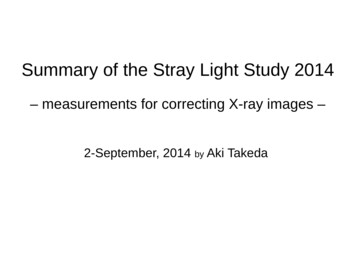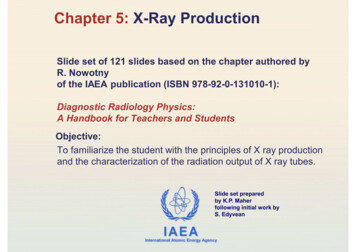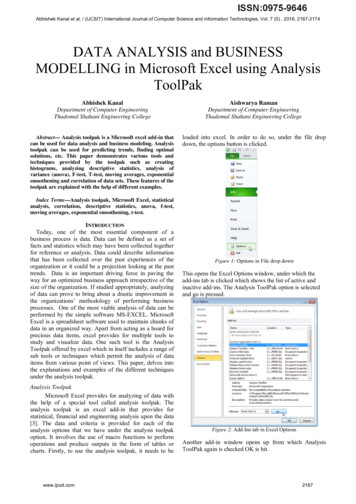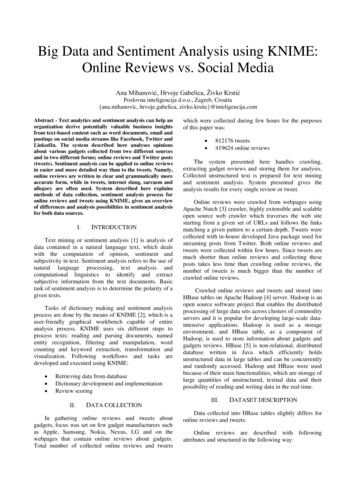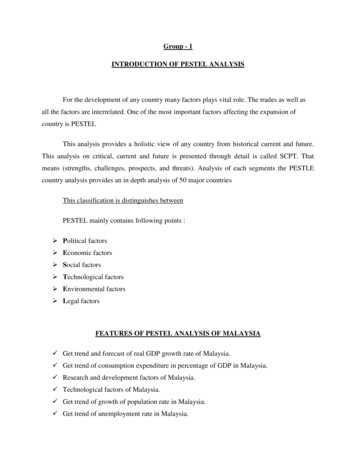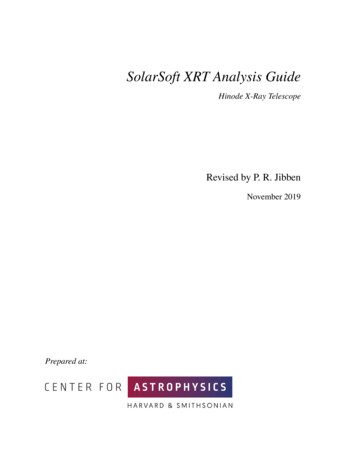
Transcription
SolarSoft XRT Analysis GuideHinode X-Ray TelescopeRevised by P. R. JibbenNovember 2019Prepared at:
November 2019 Revision:Updated the Coaligning XRT sectionUpdated the Known Issues sectionUpdated the Contamination sectionUpdated Stray Light Section sectionJune 2018 Revision:Added list of URLs after Table of Contents.Added section: Browsing Data to Chapter 2.Added section: Known Issues to Chapter 2.Added xrt teem ch.pro to Section 2.11.Added subsection: Using xrt dem iterative2.pro to Chapter 2.May 2017 Revision:Added section about the Point Spread Function.Added link to the XRT Level 0 MPEG archive in Table 2.1.October 2016 Revision:Added information about the 14 June 2015 light leak to Section 2.4.4 Light Leak.Updated the XRT paper references in Table 1.2.Corrected the fits keyword definitions of CRPIX1 and CRPIX2 in the Appendix.Previous revisions by:Patrick McCauleyPaola TestaOriginally written by:Monica Bobra & Mark Weberand other members of the XRT team
Contents12Introduction1.1 Hinode and the X-Ray Telescope . . . .1.1.1 Synoptic Data . . . . . . . . . .1.1.2 Eclipse Season . . . . . . . . .1.2 Overview of the Data Analysis Pipeline1.2.1 Data Transport . . . . . . . . .1.2.2 Data Products . . . . . . . . . .1.3 References . . . . . . . . . . . . . . . .1.4 Contacts . . . . . . . . . . . . . . . . .X-Ray Telescope Software Guide2.1 Browsing XRT Data . . . . . . . . . . . . . . . . . .2.2 Obtaining XRT Data . . . . . . . . . . . . . . . . .2.2.1 Darts/Hinode . . . . . . . . . . . . . . . . .2.2.2 Virtual Solar Observatory . . . . . . . . . .2.2.3 Hinode Science Data Center Europe Archive2.2.4 LMSAL Sungate Website . . . . . . . . . .2.3 Searching XRT Data with the XRT Catalog . . . . .2.3.1 Using xrt cat.pro . . . . . . . . . . . . . .2.3.2 Search Criteria Used to Select XRT Data . .2.4 Reading XRT Data . . . . . . . . . . . . . . . . . .2.4.1 Using read xrt.pro . . . . . . . . . . . . . .2.5 Calibrating XRT Data . . . . . . . . . . . . . . . . .2.5.1 Using xrt prep.pro . . . . . . . . . . . . . .2.5.2 Routines Used by xrt prep.pro . . . . . . .2.5.3 Contamination . . . . . . . . . . . . . . . .2.5.4 Light Leak . . . . . . . . . . . . . . . . . .2.6 Displaying XRT Data . . . . . . . . . . . . . . . . .2.7 Coaligning XRT Data . . . . . . . . . . . . . . . . .2.7.1 Using xrt read coaldb.pro . . . . . . . . .2.7.2 Using xrt jitter.pro . . . . . . . . . . . . .2.8 Making Composite Images with XRT Data . . . . . .2.9 Making Movies with XRT Data . . . . . . . . . . 639414242444648
CONTENTS342.10 Writing XRT Data . . . . . . . . . . . . . . . . . . . . . . . . . . .2.10.1 Using write xrt.pro . . . . . . . . . . . . . . . . . . . . .2.10.2 Using write png.pro or write bmp.pro: . . . . . . . . . .2.11 Instrument Responses and Inferring PhysicalQuantities . . . . . . . . . . . . . . . . . . . . . . . . . . . . . . .2.11.1 Filter Responses . . . . . . . . . . . . . . . . . . . . . . .2.11.2 Calculating XRT Filter Response with Non-Standard Spectra2.11.3 Using xrt teem.pro or xrt teem ch.pro . . . . . . . . . . .2.11.4 Using xrt dem iterative2.pro . . . . . . . . . . . . . . . .2.12 The XRT Point-Spread Function . . . . . . . . . . . . . . . . . . .2.12.1 Using xrt deconvolve.pro . . . . . . . . . . . . . . . . . .2.13 Known Issues . . . . . . . . . . . . . . . . . . . . . . . . . . . . . . . . . . . . . .484850.5054616572787979X-Ray Telescope Instrument Guide3.1 XRT System Overview . . . . . . . . . . .3.2 Telescope Performance . . . . . . . . . . .3.3 MDP/XRT Communications . . . . . . . .3.4 CCD Camera System . . . . . . . . . . . .3.4.1 Pointing . . . . . . . . . . . . . . .3.4.2 Exposures . . . . . . . . . . . . . .3.5 XRT Mechanisms . . . . . . . . . . . . . .3.5.1 Visible Light Shutter . . . . . . . .3.5.2 Visible Light Imager . . . . . . . .3.5.3 Focus Mechanism . . . . . . . . .3.5.4 Filter Wheel and Shutter Assembly.818181828283848485858585A Level 0 Header Keywords.87
List of Figures1.1Hinode eclipse season. . . . . . . . . . . . . . . . . . . . . . . . . . . . .10The Virtual Solar Observatory (VSO) main menu. . . . . . . . . . . . . . .Search form generated after selecting the Instrument / Source / Providerbox on the main VSO website. Hinode XRT data is provided by SAO. . . .2.3 VSO form describing the data available given the search parameters. TheCheckBox Tools menu in the left column can be helpful when selecting alarge amount of data. . . . . . . . . . . . . . . . . . . . . . . . . . . . . .2.4 VSO Data request page. . . . . . . . . . . . . . . . . . . . . . . . . . . . .2.5 Hinode Science Data Center Europe Archive Search page. Search parameters relevant to XRT are highlighted green in this image. . . . . . . . . . .2.6 Example search results from the Hinode SDC Europe Archive. . . . . . . .2.7 Lockheed Martin Solar & Astrophysics Laboratory’s Sungate website. . . .2.8 LMSAL Solarsoft XRT catalog webpage. . . . . . . . . . . . . . . . . . .2.9 Effect of contamination layer, accumulating on the CCD between a bakeoutand the next, on the XRT temperature response of Al mesh (black curves),C poly (red curves), and Be thin (blue curves). The solid lines are responsescalculated for 2009-09-24, right after a CCD bakeout, and the dashed curvesare calculated for 2009-10-15, i.e. three weeks later and just before the following bakeout. The comparison shows that in the regime of regular bakeouts, adopted since mid-2008, only the thinnest filter shows any detectable,though minimal, change in response due to accumulation of contaminatingmaterial on the CCD between bakeouts. . . . . . . . . . . . . . . . . . . .2.10 An example Al mesh image taken on 5-August-2010 at 10:01UT. Left: Theprepped data without spot correction. Right: The output image from the routine xrt spotcor.pro. The severity of the spots depends on wavelength withthe Al mesh filter being most affected. Spot correction can be done fromwithin xrt prep.pro and a spot map should be generated to locate affectedpixels. . . . . . . . . . . . . . . . . . . . . . . . . . . . . . . . . . . . . .2.11 Comparison of Ti poly images before and after light leak. . . . . . . . . . .2.12 Examples displaying XRT data in IDL. . . . . . . . . . . . . . . . . . . . .152.12.251617181920212237384041
LIST OF FIGURES2.13 Sample coalignment between XRT and AIA images using plot map. XRTimages are on the left and AIA on the right. Upper Left: XRT Map usinglevel-0 FITS header information without correction. Lower Left: Same dataafter the correction done by xrt read coaldb.pro. The image location haschanged relative to the x and y axes. The red contour in the right panel showthe position of the flaring loop in XRT images. . . . . . . . . . . . . . . . .2.14 The total telescope throughput of the XRT for each of the nine X-Ray filterchannels. Figure 17 from Golub et al. (2007). . . . . . . . . . . . . . . . .2.15 Example of XRT temperature responses calculated for two different dates.The solid lines are responses calculated for 2007-03-01, before the firstCCD bakeout, and the dashed curves are calculated for 2008-03-01, in theregime of regular bakeouts. The comparison shows how the sensitivity in thelower energy range, significantly decreased by the contamination material,has been recovered through CCD bakeout and maintained with regular CCDbakeouts. . . . . . . . . . . . . . . . . . . . . . . . . . . . . . . . . . . .2.16 Example of XRT temperature responses calculated using the default spectrum for AIA and a standard XRT spectrum: the solid lines are the responsescalculated for the standard XRT spectrum, and the dashed curves are calculated using the default spectrum for AIA. Both are calculated for the date2011 August 21. . . . . . . . . . . . . . . . . . . . . . . . . . . . . . . . .2.17 Example temperature output from xrt teem.pro using Al mesh and Al polyfilters. The units have been changed from log K to Million K. . . . . . . . .2.18 Example emission measure output from xrt teem.pro using the Al mesh andAl poly filters. . . . . . . . . . . . . . . . . . . . . . . . . . . . . . . . . .2.19 Example output from xrt deconvolve with and without using a saturationmask. . . . . . . . . . . . . . . . . . . . . . . . . . . . . . . . . . . . . .3.1XRT filter wheels as viewed from the sun. . . . . . . . . . . . . . . . . . .64553616669708086
List of Tables1.11.2XRT Data Types . . . . . . . . . . . . . . . . . . . . . . . . . . . . . . .XRT References . . . . . . . . . . . . . . . . . . . . . . . . . . . . . . .11122.12.2XRT Data Browsing Resources . . . . . . . . . . . . . . . . . . . . . . .Summary of Stray Light Events and Links to Analysis Webpages . . . .14403.13.2X-Ray Performance . . . . . . . . . . . . . . . . . . . . . . . . . . . . .Optical Performance . . . . . . . . . . . . . . . . . . . . . . . . . . . . .81827
List of URLshttp://adsabs.harvard.edu/abs/1992PhyS.46.202F . . . . . . . . . . 94http://adsabs.harvard.edu/abs/2007PASJ.59S.845S . . . . . . . . . . 94http://adsabs.harvard.edu/abs/2007SoPh.243.63G . . . . . . . . . . 94http://adsabs.harvard.edu/abs/2008SoPh.249.263K . . . . . . . . . . 94http://adsabs.harvard.edu/abs/2011SoPh.269.169N . . . . . . . . . . 94http://adsabs.harvard.edu/abs/2014SoPh.289.1029N . . . . . . . . . . 94http://adsabs.harvard.edu/abs/2014SoPh.289.2781K . . . . . . . . . . 94http://adsabs.harvard.edu/abs/2016AJ.152.107A . . . . . . . . . . 94http://adsabs.harvard.edu/abs/2016SoPh.291.317T . . . . . . . . . . 94http://fits.gsfc.nasa.gov . . . . . . . . . . . . . . . . . . . . . . . . . ies/ . . . . . . . . 14http://hinode.nao.ac.jp/en/gallery/latest/ . . . . . . . . . . . . . . 13http://sdac.virtualsolar.org/cgi-bin/search . . . . . . . . . . . . . . 14http://sdc.uio.no/search/ . . . . . . . . . . . . . . . . . . . . . . . . . /latest month.html .10, 14http://solar.physics.montana.edu/HINODE/XRT/lev0 mma/ . . . . . . . 14http://solar.physics.montana.edu/HINODE/XRT/xrt u/takeda/xrt sl2015/xrt15 xrt sl2017/xrt17 xrt sl2018/xrt18 xrt straylight/xrt sl summary.html . . . . . . . . . . . . . . . . . . . . . . . . . . . . . . . . . . . . . . 40http://www.lmsal.com/solarsoft/ . . . . . . . . . . . . . . . . . . . . . . 13http://www.lmsal.com/sungate/ . . . . . . . . . . . . . . . . . . . . . . . 21http://xrt.cfa.harvard.edu . . . . . . . . . . . . . . . . . . . . . .12, 14http://xrt.cfa.harvard.edu/focus catalog/ . . . . . . . . . . . . . . . napview.html . . AG/XAG.pdf . . . . 73http://xrt.cfa.harvard.edu/xpow/ . . . . . . . . . . . . . . . . . . . . . de/coalignment/ . de/coalignment/samples/ . . . . . . . . . . . . . . . . . . . . . . . . . . . . . . . . . . . . 44http:/xrt.cfa.harvard.edu/flare catalog/ . . . . . . . . . . . . . . . . 14https://darts.isas.jaxa.jp/solar/hinode/ . . . . . . . . . . . . . . . . 13https://helioviewer.org/ . . . . . . . . . . . . . . . . . . . . . . . . . . 14https://hinode.isee.nagoya-u.ac.jp/thesis.input/ . . . . . . . . . . zip/zip/entry/index.html . . . . . . . . . . . . . . . . . . . . . . . . . . . . . . . . . . . . . . 63
IntroductionThis document consists of a Software Guide (Chapter 2) and Instrument Guide (Chapter 3).The Software Guide describes how to analyze XRT data; the Instrument Guide gives a broadoverview of the X-Ray Telescope’s hardware components.1.1Hinode and the X-Ray TelescopeHinode is a joint mission between the space agencies of Japan, United States, Europe, andUnited Kingdom. The craft carries three instruments, a Solar Optical Telescope (SOT),Extreme Ultraviolet Imaging Spectrometer (EIS) and X-Ray Telescope (XRT); together, theyare designed to provide multi-wavelength data from the photosphere to the upper corona. The875-kg craft was launched on September 23, 2006 into a polar, sun-synchronous orbit at 600kilometers with an inclination of -98 , allowing 9 months of continuous observations and a3-month eclipse season. Hinode provides approximately 7 GB of data daily.The XRT images coronal plasmas from 1 to approximately 20 million K with 200 resolution ( 100 pixels). The XRT images through nine X-ray filters using two filter wheels.The XRT also contains a visible light optic that takes G-band images for alignment. Theback-thinned CCD has 2048 2048 pixels and images over a 350 350 field of view, thoughpartial frame images of various sizes can be read from select areas of the CCD. XRT takesapproximately 0.7 GB of data daily as lossless or one of nine forms of lossy JPEG compression.The baseline duration of the mission is 3 years. Currently XRT, SOT and EIS are operatedfrom the Institute of Space and Astronautical Science (ISAS) in Sagamihara, Japan. See theInstrument Guide (Chapter 3) for more information.1.1.1Synoptic DataThe Hinode craft points at sun center for 10 minutes 2-4 times a day, enabling XRT totake synoptic data in the form of full-resolution, full-disk images with both long and shortexposures in one or more X-ray filters. The long and short exposures are taken to capturethe dynamic range of the coronal plasma’s X-ray emission and thus the saturated pixels fromthe long exposure are replaced with corresponding pixels in the short exposure pair. Thepair is then available as one image in a form referred to as Level 2 data (See Section 1.2.2).9
CHAPTER 1. INTRODUCTION10Synoptic Level 2 data is available A/latest month.html.1.1.2Eclipse SeasonThe Hinode craft is in a polar, sun-synchronous orbit at 600 kilometers with an inclinationof -98 , allowing 9 months of continuous observations and a 3-month eclipse season. Theeclipse season begins in May every year; eclipse durations are shown in Figure 1.1. Effects ofatmospheric absorption will be visible in XRT images beginning 4 days before the seasonthrough to 4 days after the season, for a total of 100 days.Figure 1.1: Hinode eclipse season.1.21.2.1Overview of the Data Analysis PipelineData TransportXRT downlinks 15 times daily at the Svalbard Ground Station, a member of the Norwegian Space Centre (NSC). Downlinks also occur up to four additional times daily at any oneof the Japanese Aerospace Exploration Agency (JAXA) ground station network antennas,which include two Japanese sites, in the Kagoshima and Ibaraki prefectures, as well as threeoverseas sites: Maspaolomas, Canary Islands, Perth, Australia, and Santiago, Chile. Downlinked XRT telemetry is sent to the ISAS mission archive, the principal XRT data site, forreformatting to create Level 0 data. Both QuickLook and Level 0 data are then mirroredto the Smithsonian Astrophysical Observatory (SAO), in Cambridge, MA. Using the dataretrieval techniques described in Section 2.2, users access machines at SAO to obtain XRTdata.
CHAPTER 1. INTRODUCTION1.2.211Data ProductsXRT data is available as FITS files, each of which include a data array and a metadatastructure array containing a list of keywords (see Appendix 1). Several types of data productsare available: QuickLook, Level 0, Level 1, and Level 2.QuickLook data are expedited to ISAS so XRT operation team members can view images a few hours after the data has been taken. However, these data have not been completelyreformatted and thus the images may not be whole and the FITS keywords will not be populated completely or correctly. XRT team members use this data to make operations decisionsbut these data products are not suitable for scientific purposes.Level 0 data contains whole images; in addition, the FITS keywords have been populatedcorrectly by the reformatter. Level 0 data cannot be created until all the housekeeping datafor a particular observation has arrived at ISAS, which may take up to 7 days. Level 1 datahas been calibrated by xrt prep.pro and has units of instrumental Data Numbers. Level 2data has been further processed into more physical units or into movies. The following tabledescribes each of the XRT data products:Table 1.1: XRT Data TypesLevelPixel valuesFile formatPurposeQuickLook Data Number (DN)FITSOperations, Data Verification,QuickLook movies0DNFITSBasic science1DN/secFITSCalibrated images2Physical unitsAnyShort and long exposuressummed into one image;Differential Emission Measure;Temperature MapsXRT instrument data are available as single Level 0 FITS files with names in the theformat XRTYYYYMMDD HHMMSS.S.fits. The files stored in directories organized byhour beneath directories organized by day, month, and year. An example of a directorystructure to access an individual FITS file is as follows:YYYY/MM/DD/Hhh00/, or 2007/05/27/H1300.
CHAPTER 1. INTRODUCTION1.312ReferencesTable 1.2: XRT ReferencesInstrument paperGolub et al. 2007Camera paperKano et al. 2008Calibration paperKobelski et al. 2014Measuring uncertaintiesKobelski et al. 2014Temperature ResponseNarukage et al. 2011 & Narukage et al. 2014Synoptic ImagesTakeda et al. 2016XRT images in the popular media should be credited to SAO/NASA/JAXA/NAOJ. Pleasecheck the current Hinode data thesis projects webpage prior to publishing input/For more information about Hinode XRT visit the website:http://xrt.cfa.harvard.edu.1.4ContactsFor data analysis problems, contact xrt manager[at]cfa.harvard.edu.For science discussions, contact xrt science[at]cfa.harvard.edu.
X-Ray Telescope Software GuideThis chapter outlines how to analyze XRT data using software publicly available as partof SSWIDL (to add an instrument path to a SSWIDL tree, see http://www.lmsal.com/solarsoft/). This process involves obtaining, searching, reading, calibrating, coaligningand writing XRT data, as well as constructing Level 2 data products such as long-shortcomposite images and various temperature analyses.2.1Browsing XRT DataThere are several resources available for browsing XRT data, all of which can be accessed atthe XRT webpage. Table 2.1 provides links to the resource along with a brief description ofwhat is available there.The XRT data Snapview webpage presents a visual representation of XRT data that includes pointing and filter information and links to the VSO website. The XRT SynopticGallery provides daily full-disk solar images and the XRT flare catalog details every flareobserved by XRT and links to flare data (VSO website). The Level 0 MPEG movie archiveprovides MPEG movies of the XRT Level 0 data. Users can quickly check data availabilityand quality before accessing the archive. New tools and catalogs are always being developedand users are encouraged to visit the XRT webpage to find the latest data products available.2.2Obtaining XRT DataXRT data can be obtained from several outlets including the Darts/Hinode (ISAS, JAXA),the Virtual Solar Observatory (VSO), the Hinode Science Data Center Europe Archive, andthe Lockheed Martin Solar & Astrophysics Laboratory (LMSAL) Sungate website.2.2.1Darts/HinodeThe DARTS/Hinode website is at https://darts.isas.jaxa.jp/solar/hinode/. Hereusers can find data and information for all three Hinode instruments, including XRT. Datacan be downloaded from this website. A very useful feature at this website is the HinodeLatest Images.13
CHAPTER 2. X-RAY TELESCOPE SOFTWARE GUIDE14Table 2.1: XRT Data Browsing ResourcesXRT //helioviewer.org/XRT INODE/XRT/SCIA/latestmonth.htmlXRT L0 v0 mma/ArchiveHinode QLMovie qlmovies/XRT FlareCataloghttp:/xrt.cfa.harvard.edu/flare catalog/XRT FocusCataloghttp://xrt.cfa.harvard.edu/focus missionops/snapview/snapview.htmlXRT Picture ofhttp://xrt.cfa.harvard.edu/xpow/the Week2.2.2Virtual Solar ObservatoryThe VSO website, Figure 2.1, is at: http://sdac.virtualsolar.org/cgi-bin/searchand allows users to search for solar data from several observatories. Users can select one ormore ways to search for solar data by checking off the boxes they want and clicking theGenerate VSO Search Form button located at the bottom of the screen. Currently, theVSO offers Level 1 XRT data as defined in Table 1.1. XRT data can be found in a varietyof ways using this search form. If you are interested in searching XRT data based on theObservable option then you can check the intensity box after you click on the GenerateVSO Search Form button. The Instrument/Source/Provider box creates a form to searchfor data based on an instrument or data archive. The other categories of interest to XRT datausers are Spectral Range (soft X-Rays [1 - 100Å]), and Nickname (Soft X-Ray image).The direct way of finding XRT data is by searching by Instrument/Source/Provider.This creates a list of solar data currently a member of the VSO. The VSO generated searchform is displayed in Figure 2.2. Once the time and instrument have been selected, choosethe Search button underneath the date. HINT: To change the date, change both years first,then both months, then both days. Otherwise the dates will automatically readjust.Data for the dates of interest will appear in a form as seen in Figure 2.3. The left menu
CHAPTER 2. X-RAY TELESCOPE SOFTWARE GUIDE15bar provides users with several ways to select the data. A user can select data by checkingthe box next to the desired entry or by using the CheckBox Tools menu where data can beselected above or below a selected box. Once all of the data has been selected click on theRequest Data button in the left menu.Users are then directed to a page where they can select how to receive the data. Datacan be downloaded via a URL or by creating a .tar file that will place the requested files ina staging area (see Figure 2.4). When selecting the tar file option, an email address may berequired.Figure 2.1: The Virtual Solar Observatory (VSO) main menu.
CHAPTER 2. X-RAY TELESCOPE SOFTWARE GUIDE16Figure 2.2: Search form generated after selecting the Instrument / Source / Provider boxon the main VSO website. Hinode XRT data is provided by SAO.
CHAPTER 2. X-RAY TELESCOPE SOFTWARE GUIDE17Figure 2.3: VSO form describing the data available given the search parameters. The CheckBox Tools menu in the left column can be helpful when selecting a large amount of data.
CHAPTER 2. X-RAY TELESCOPE SOFTWARE GUIDE18Figure 2.4: VSO Data request page.2.2.3Hinode Science Data Center Europe ArchiveThe Archive Search page at the Hinode SDC Europe, http://sdc.uio.no/search/, hasdata from Hinode’s three instruments (XRT, EIS, and SOT). The main page is shown inFigure 2.5.Figure 2.6 shows a typical results page output, which includes thumbnails (both a sampleimage from a dataset and its field of view superimposed on a context synoptic image). The‘Action’ column contains several icons for selection of data to download. Once data areselected, they can be retrieved by clicking on the Retrieve button at the bottom of the page.You will need to enter an email address to which the system will send a notification andinstructions on how to download the data once they are ready.At the top of the webpage is a list of current instrument data in the archive. You canselect XRT data here. In the STATUS: menu select ‘Level 0’ data to get unprocessed data.Finally, you must provide a range of dates by entering the date(s) in the EPOCH START andEPOCH END fields. Once the desired parameter values have been selected click the Searchbutton.
CHAPTER 2. X-RAY TELESCOPE SOFTWARE GUIDE19Figure 2.5: Hinode Science Data Center Europe Archive Search page. Search parametersrelevant to XRT are highlighted green in this image.
CHAPTER 2. X-RAY TELESCOPE SOFTWARE GUIDEFigure 2.6: Example search results from the Hinode SDC Europe Archive.20
CHAPTER 2. X-RAY TELESCOPE SOFTWARE GUIDE2.2.421LMSAL Sungate WebsiteHinode XRT data may also be collected from the LMSAL Sungate webpage (Figure 2.7).http://www.lmsal.com/sungate/There are multiple ways to search for XRT data. There is a direct link to the Hinode XRTcatalog on this webpage as well as the Heliophysics Coverage Registry (HCR). Clicking theHinode XRT Archive link will bring you to the search page shown in Figure 2.8.The additional pages listed on the main page provide different routes to the data; eachpage is equipped with explanations.Figure 2.7: Lockheed Martin Solar & Astrophysics Laboratory’s Sungate website.
CHAPTER 2. X-RAY TELESCOPE SOFTWARE GUIDEFigure 2.8: LMSAL Solarsoft XRT catalog webpage.22
CHAPTER 2. X-RAY TELESCOPE SOFTWARE GUIDE2.323Searching XRT Data with the XRT CatalogThe XRT catalog contains a subset of XRT FITS header keywords, (such as field of view,filter positions, and image type), for every XRT observation. Using the catalog is a usefulway to search data without downloading any of it. The catalog may be read and listed usingthe routine xrt cat.pro.In order to use this code, some ancillary XRT files are necessary and can be installedby running sswdb upgrade from within SSWIDL and adding the hinode/xrt branch of theSSWDB tree.2.3.1Using xrt cat.proThis program returns XRT catalog records suitable for selecting data as a structure array.In the following example, the OFILES keyword generates a list of files using the subroutinexrt cat2files.pro:IDL t0 ‘2007-04-18T02:30:00’IDL t1 ‘2007-04-18T12:30:00’IDL xrt cat, t0, t1, catx, ofilesIDL help, catxCATXSTRUCT - Anonymous Array[311]IDL help, ofilesOFILESSTRING Array[311]There are several input and output keywords that can be set to provide additional information.Optional input keyword parameters:SEARCH ARRAY: (See struct where.pro) Give a set of search parameters to further refinethe data set.EXTRA: (Various possible types) Unknown parameters assumed to be inPARAM VALUE pairs (see struct where.pro)./SIRIUS: (Boolean) If set, then return Level 0 data. This is the default. Overrides/QUICKLOOK./QUICKLOOK: (Boolean) If set, then return Quicklook data instead of Level 0 data. Overridden by /SIRIUS./URLS: (Boolean) If set, then return OFILES as URLs to a remote data server. (Default isto give local full paths.)/REFRESH: (Boolean) If set, then refresh the cache (i.e., re-read the catalog).
CHAPTER 2. X-RAY TELESCOPE SOFTWARE GUIDE24/TEMP: (Boolean) If set, then use a temporary (i.e., offline/in-progress) catalog database./VERBOSE: (Boolean) If set, print out extra information. Overrides /QUIET. There arethree levels of verbosity, in order of priority: (1) VERBOSE displays all errors and messages.(2) QUIET suppresses all errors and messages. (3) No keyword displays all errors and somemessages./QUIET: (Boolean) If set, suppress messages./QSTOP: (Boolean) For debugging.Optional output keyword parameters:OFILES: (string array, [Nimg ]) List of full path filenames for the Level 0 data matchingthe catalog. If /URL, then instead returns data paths to a remote data server. This list isgenerated by a call to the program xrt cat2files.pro.ERROR: (scalar number) Returns the ERROR keyword value from a call toread genxcat.pro.QABORT: (Boolean) Indicates that the program exited gracefully without completing.0: Program ran to completion.1: Program aborted before completion.2.3.2Search Criteria Used to Select XRT DataFurther searching of XRT data can be done at the IDL command line using FITS keywords.All FITS values are in uninterpreted binary, with the exception that enumerated values aresometimes represented by string values instead of an integer. XRT follows with standardFITS file naming conventions, available at http://fits.gsfc.nasa.gov. A completelist of Level 0 XRT header keywords is provided in Appendix A. The following FITS filekeywords may be of use.EC IMTY : Image type; input string values of ‘dark’ or ‘normal’.EC FW1 : Filter Wheel 1 position; input string values of ‘Open’, ‘Al poly’, ‘C poly’,‘Be thin’, ‘Be med’, ‘Al med’EC FW2 : Filter Wheel 2 position; input string values of ‘Open’, ‘Al mesh’, ‘Ti poly’,‘Gband’, ‘Al thick’, ‘Be thick’EC VL : Visible light shutter position; input string values of ‘open’ or ‘closed’.NAXIS1: General FITS keyword for pixel length in the x-direction; input integer value.XRT images are generally 384 384, 512 512 or 1024 1024; though any given area ofthe CCD can be read out.
CHAPTER 2. X-RAY TELESCOPE SOFTWARE GUIDE25NAXIS2: General FITS keyword for pixel length in the y-direction; input integer value.Basic filter example:IDL ss where(catx.ec imty eq ‘normal’ and catx.naxis1 eq 512)The following keywords are not useful for searching purposes, but are quite useful for interpretation purposes:EXPTIME : This keyword represents the duration of the CCD exposure for normal imagesin seconds. EXPTIME is useful for sorting long/short pairs.(DAT
Updated Stray Light Section section June 2018 Revision: Added list of URLs after Table of Contents. Added section: Browsing Data to Chapter 2. Added section: Known Issues to Chapter 2. Added xrt teem ch.pro to Section 2.11. Added subsection: Using xrt dem iterative2.pro to Chapter 2. May 2017
